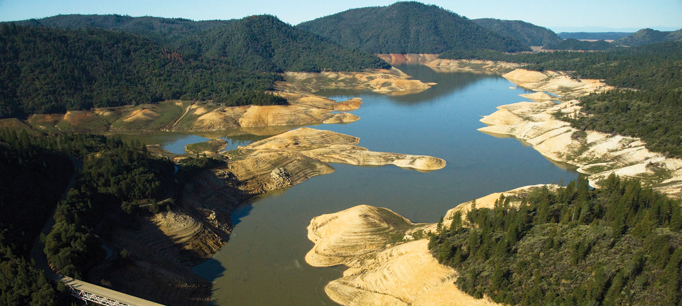This is part of a continuing series on the impact of the drought.
California’s rainy season is pretty much over. Most years, 85% of the wet season’s rain and snow has already fallen by late March. While rain often falls in April and May, it is rarely enough to make a big difference in the overall water picture, and the forecast is now quite dry.
That means California’s water managers now have a good idea how much water will be available in the state’s reservoirs, snowpack, and groundwater basins.
The news is not heartening. While parts of the north coast did fairly well, the rest of California did not. The Sierras received about half of annual average precipitation. And as the record warm temperatures of last year have persisted, the snowpack is at an all-time low (now 8% of average). As California’s struggling ski area operators know all too well, most precipitation fell as rain, rather than snow.
 Statewide, reservoir storage is about half of capacity. However, the almost non-existent snowpack provides no prospect for improvement in storage this spring—something water managers count on in most years.
Statewide, reservoir storage is about half of capacity. However, the almost non-existent snowpack provides no prospect for improvement in storage this spring—something water managers count on in most years.
This fourth consecutive dry year have led to some dire, even apocalyptic predictions, including that California will run out of water within a year. While managing this drought will be difficult, even painful in some regions, the state is not going to run out of water and there is no need to panic. Rather, prudent adjustments to water scarcity that began earlier in the drought will continue and intensify. These include:
- Increased urban conservation. Californians cut their per capita water use last year, but they can do more. In particular, there is ample room to reduce outdoor watering, which makes up roughly half of urban water use. The State Water Resources Control Board has tightened restrictions on outdoor water use, and many municipalities will increase their conservation efforts.
- Increased water trading. Robust water markets, involving willing sellers and buyers, are an effective way to manage scarcity. The Australians found this to be helpful during their crippling Millennium Drought. California’s water market helped many farmers keep their orchards alive in 2014. This year, cities with dwindling drought reserves are also looking to buy water – as illustrated by the recent deal between Sacramento Valley rice farmers and Metropolitan Water District, Southern California’s large water wholesaler. As demand for trading increases, so will water prices.
- Increased use of groundwater. Groundwater pumping has grown since the drought’s onset, but California’s reserves of groundwater remain large—particularly compared to surface storage. Groundwater will continue to make up shortfalls in surface water this year. Unfortunately, past failures to manage groundwater have lowered the water tables in many basins, making water more expensive to extract and often requiring drilling new, deeper wells. The new Sustainable Groundwater Management Act will eventually address this problem, but not soon enough for this drought.
In short, California is not running out of water, just cheap water. A fourth consecutive year of drought will make both water scarcity and management possibilities increasingly apparent.




